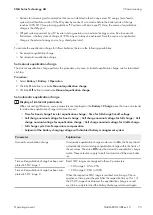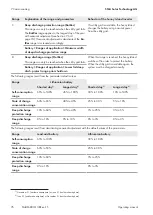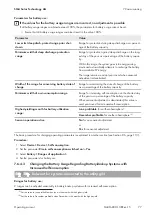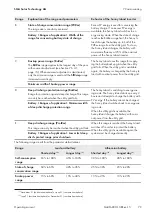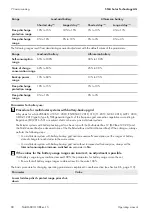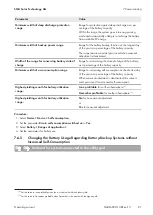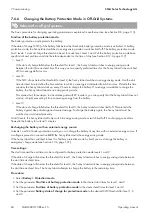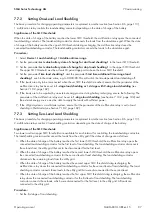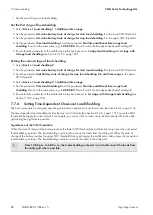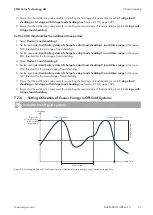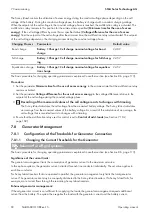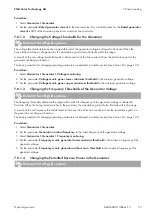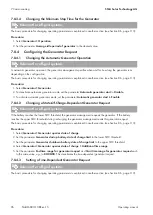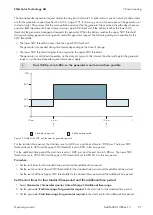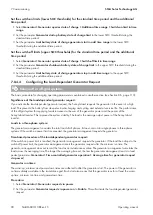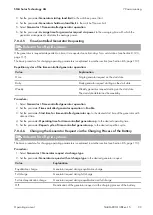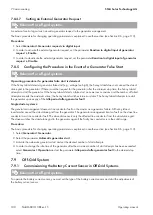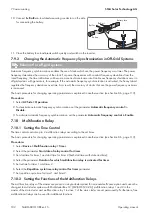
7 Commissioning
SMA Solar Technology AG
Operating manual
87
SI44M-80H-13-BE-en-15
7.7.2
Setting One-Level Load Shedding
1 multifunction relay controls the load-shedding contactor depending on the state of charge of the battery.
Significance of the SOC thresholds:
When the state of charge of the battery reaches the lower SOC threshold, the multifunction relay opens the connected
load-shedding contactor. The load-shedding contactor disconnects the loads from the stand-alone grid. When the state
of charge of the battery reaches the upper SOC threshold during recharging, the multifunction relay closes the
connected load-shedding contactor. The load-shedding contactor connects the loads to the stand-alone grid.
Procedure:
1. Select
Device > Load shedding 1 > Additional time range
.
2. Set the parameter
Lmt value battery state of charge for start load shedding 1
to the lower SOC threshold.
3. Set the parameter
Lmt value battery state of charge for stop load shedding 1
to the upper SOC threshold.
The upper SOC threshold must be at least 10 percentage points above the lower SOC threshold.
4. Set the parameter
Time load shedding 1
and the parameter
Start time additional time range load
shedding 1
each to the same value, e.g. to 00:00:00. This will switch the time-dependent load shedding off.
5. If the loads are only to be reconnected when the set SOC threshold is reached, ensure that the parameter of the
multifunction relay has been set to
1-stage load shedding or 1st stage with 2-stage load shedding
6. If the loads are to be supplied by an external energy source during battery recharging, ensure the following: The
parameter of the multifunction relay must be set to
1-stage load shedding
(see Section 7.10.2, page 102) and
the external energy source must be able to supply the loads with sufficient power.
7. If the off-grid system is a multicluster system, ensure that the parameter of the multifunction relay is set to Load
shedding in Multicluster (see Section 7.10.2, page 102).
7.7.3
Setting Two-Level Load Shedding
2 multifunction relays control 2 load-shedding contactors depending on the state of charge of the battery.
Significance of the SOC thresholds:
Two lower and two upper SOC thresholds are available for each interval for controlling the load-shedding contactors.
The load-shedding contactors disconnect the loads from the utility grid if the states of charge are as follows:
• When the state of charge of the battery reaches the first lower SOC threshold, the multifunction relay opens the
connected load-shedding contactor for the first level of load shedding. The load-shedding contactor disconnects
those loads from the utility grid that are to be disconnected for the first level.
• When the state of charge of the battery reaches the second lower SOC threshold, the multifunction relay opens
the connected load-shedding contactor for the second level of load shedding. The load-shedding contactor
disconnects the remaining loads from the utility grid.
• When the state of charge of the battery reaches the second upper SOC threshold during recharging, the
multifunction relay closes the connected load-shedding contactor for the second level of load shedding. The load-
shedding contactor connects those loads to the utility grid that were disconnected for the second level.
• When the state of charge of the battery reaches the first upper SOC threshold during recharging, the multifunction
relay closes the connected load-shedding contactor for the first level of load shedding. The load-shedding
contactor connects those loads, which were disconnected for the first level, to the utility grid. All loads are
connected to the utility grid.
Procedure:
• Set the first stage of load shedding.

